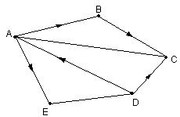AAPL wrote:GMAT Paper Tests

In the diagram above, points A, B, C, D, and E represent the five teams in a certain league in which each team must play each of the other teams exactly once. The segments connecting pairs of points indicate that the two corresponding teams have already played their game. The arrows on the segments point to the teams that lost; the lack of an arrow on a segment indicates that the game ended in a tie. After all games have been played, which of the following could NOT be the percent of games played that ended in a tie?
A. 10%
B. 20%
C. 30%
D. 40%
E. 50%
$$?\,\,\,:\,\,\,{\rm{impossible}}\,\,\% \,\,{\rm{tie}}\,\,{\rm{pairs}}$$
$${\rm{Total}}\,\,\# \,\,{\rm{games}}\,\,\,{\rm{ = }}\,\,\,{\rm{C}}\left( {5,2} \right)\,\, = \,\,10\,\,\,\left\{ \matrix{
\,5\,\,{\rm{victory - loss}}\,\,{\rm{pairs}} \hfill \cr
\,2\,\,{\rm{tie}}\,\,{\rm{pairs}} \hfill \cr
\,\left( * \right)\,\,{\rm{ = }}\,\,\,{\rm{remaining}}\,\,3\,\,{\rm{pairs}} \ldots \,\,{\rm{what}}? \hfill \cr} \right.$$
$$\left( * \right)\,\,\, = \,\,\,3\,\,{\rm{victory - loss}}\,\,{\rm{pairs}}\,\,\,\,\,\, \Rightarrow \,\,\,\,\,\,\left\{ \matrix{
\,5 + 3\,\,{\rm{victory - loss}}\,\,{\rm{pairs}} \hfill \cr
\,2\,\,{\rm{tie}}\,\,{\rm{pairs}} \hfill \cr} \right.\,\,\,\,\,\,\,\, \Rightarrow \,\,\,\,\,\,\min \left( {\,\% \,\,{\rm{tie}}\,\,{\rm{pairs}}\,} \right) = {2 \over 10} = 20\% $$
The correct answer is therefore (A).
This solution follows the notations and rationale taught in the GMATH method.
Regards,
Fabio.




















